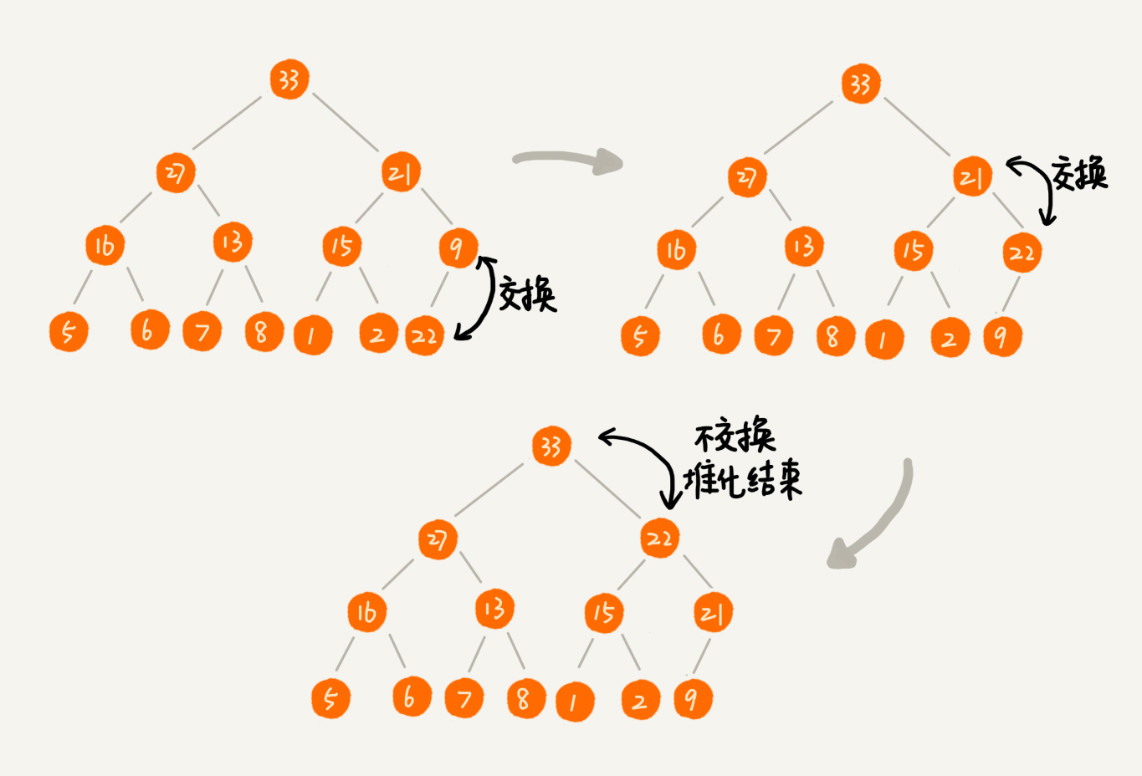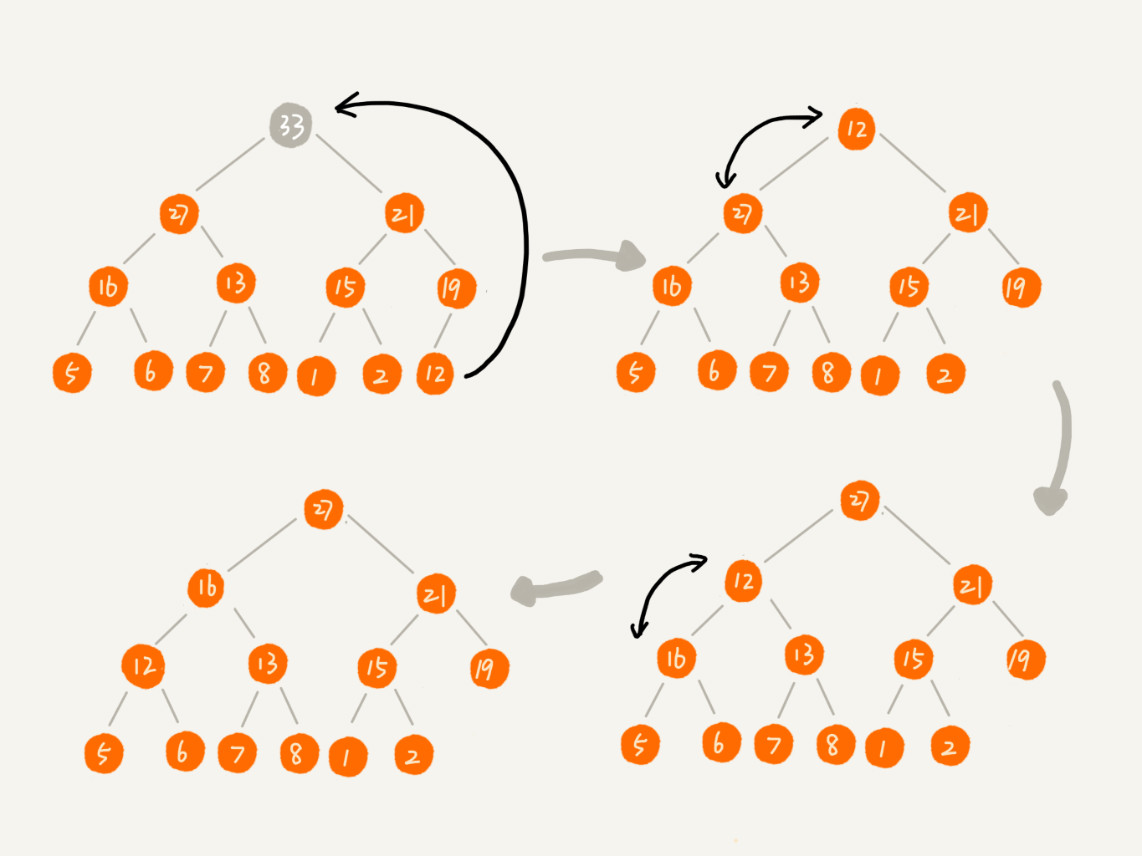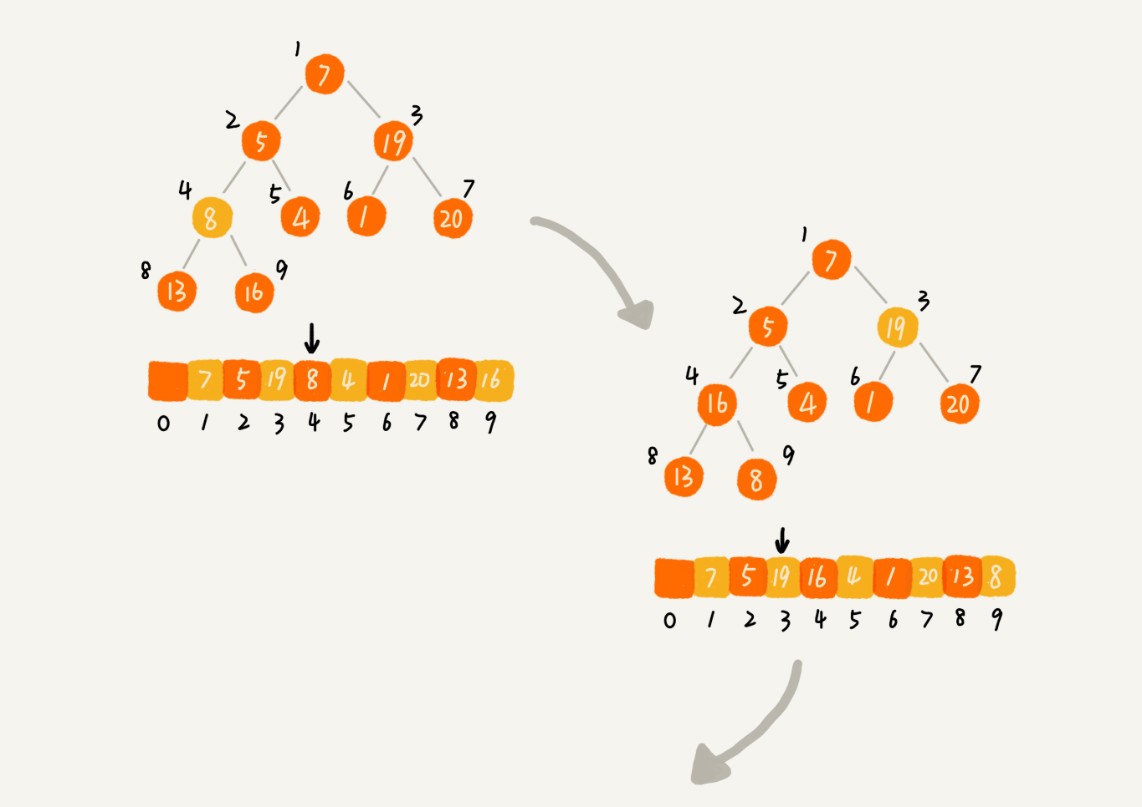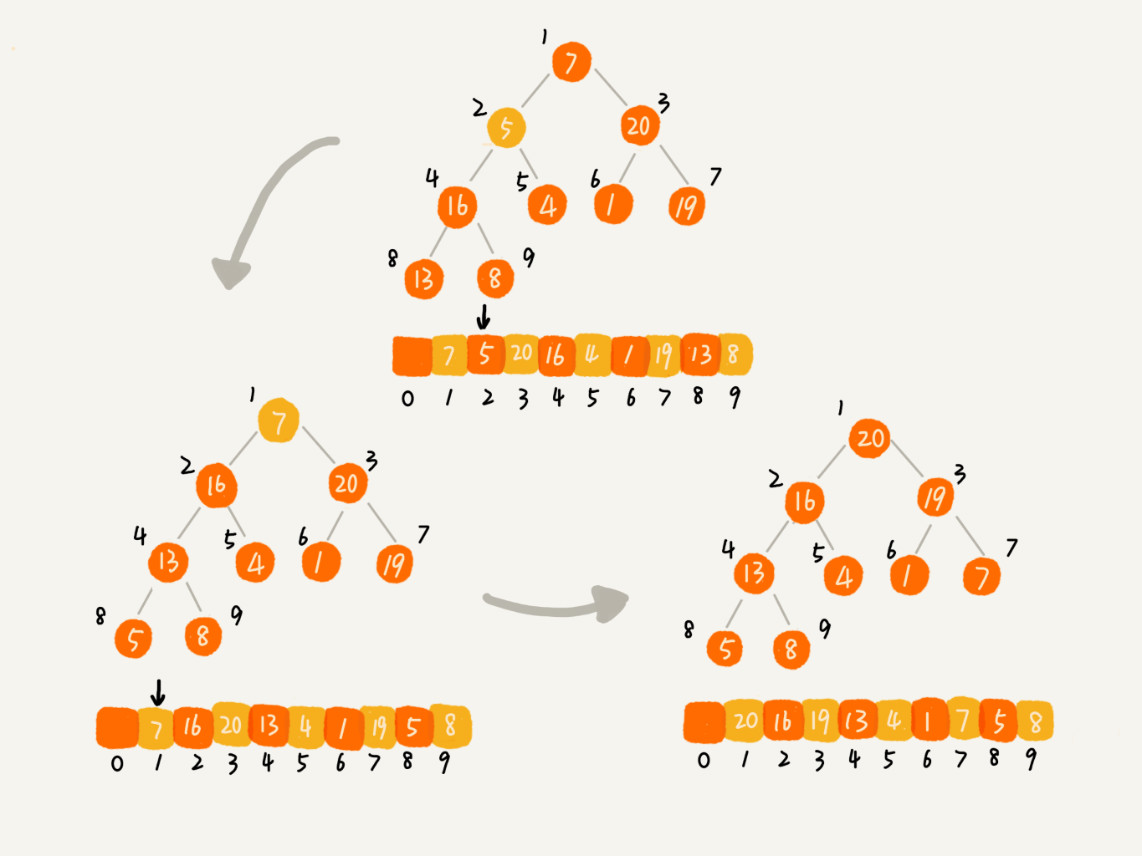>[success] # 創建堆
~~~
1.創建堆類的方法說明
1.1.getLeftIndex -- 獲取左側節點對應數組實際位置
1.2.getRightIndex -- 獲取右側節點對應數組實際位置
1.3.getParentIndex -- 獲取父節點對應數組實際位置
1.4.size -- 堆的大小
1.5.isEmpty -- 堆是否為空
1.6.clear -- 清除堆
1.7.findMinimum -- 求出堆的最小值這里指是最小堆類,最大堆最小堆根接地是對應最大值最小值
1.8.insert -- 堆中插入數據
1.9.siftUp -- 插入數據的比較方法
1.10.extract -- 移除最小堆的最小值
1.11.siftDown -- 從上向下比較進行交換找到最小值
1.12.heapify -- 堆化一個數組
~~~
>[info] ## 代碼實現 -- 最小堆
~~~
1.'siftUp' 上移操作方法說明,當往堆中插入一個元素后,將元素插入數組末尾,依次讓該元素和其父節點
進行比較,根據創建的大小堆來決定是否和父節點更換位置 -- '當做堆的插入時候用這個思想'
2.'siftDown' 從上向下比較進行交換找到最小值 -- '當做刪除的時候用這個思想,這里的刪除指的是刪除最大或最小'
3.'heapify' 數組堆化,實際只要將非葉子節點,進行堆化后自然就形成了堆,因此循環是二分之一
~~~
* siftUp 圖解

* siftDown 圖解

* heapify 圖解
~~~
1.二叉堆用的是數組的形式,我們想把一個數組變成堆,最簡單的方法,我們循環這個數組一次通過siftUp
插入數組中的 數據
2.第二種就是將整個數組先看成樹,然后將樹這個樹 拆分成小樹,這些小樹通過'siftDown'進行重新排序,
這里要說明的是我們'siftDown'是一個抽離方法,他其實是根節點和下面的子節點進行比較
3.堆的長度的一半是個個根節點,我們有這些數據分成小樹,這些小的樹堆化后就會形成大的樹
~~~


~~~
1.'說明': 首先我們針對的是二叉堆操作,其次我們一直遵循'siftUp'這種插入規則所以依次比較父節點是沒問題的
2.'siftUp' -- 對應插入
3.'siftDown' -- 對應的是刪除。因為二叉堆要不就最大堆,要不就是最小堆,這里的刪除指的是刪除堆頂
~~~
~~~
const Compare = {
LESS_THAN: -1,
BIGGER_THAN: 1,
EQUALS: 0
};
function defaultCompare(a, b) {
if (a === b) {
return Compare.EQUALS;
}
return a < b ? Compare.LESS_THAN : Compare.BIGGER_THAN;
}
function reverseCompare(compareFn) {
return (a, b) => compareFn(b, a);
}
function swap(array, a, b) {
/* const temp = array[a];
array[a] = array[b];
array[b] = temp; */
[array[a], array[b]] = [array[b], array[a]];
}
class MinHeap {
constructor(compareFn = defaultCompare) {
this.compareFn = compareFn;
this.heap = []
}
// 計算左側節點數在數組對應位置
getLeftIndex(index) {
return (2 * index) + 1
}
// 計算右側節點數組對應位置
getRightIndex(index) {
return (2 * index) + 2
}
// 計算父節點位置
getParentIndex(index) {
if (index === 0) {
return undefined
}
return Math.floor((index - 1) / 2)
}
// 計算堆得大小
size() {
return this.heap.length
}
// 判斷是否為空
isEmpty() {
return this.size() <= 0
}
// 清空堆
clear() {
this.heap = []
}
// 找到堆的最小值,因為這是最小堆,所以根節點是最小的
findMinimum() {
return this.isEmpty ? undefined : this.heap[0]
}
// 插入
insert(value) {
// 插入的時候判斷不能插入為空
if (value != null) {
const index = this.heap.length
this.heap.push(value)
this.siftUp(index)
return true
}
return false
}
// 插入數據
siftUp(index) {
let parent = this.getParentIndex(index)
// 從下向上和自己的父節點進行比較,來換彼此位置
while (index > 0 && this.compareFn(this.heap[parent], this.heap[index]) === Compare.BIGGER_THAN) {
swap(this.heap, parent, index);
index = parent
parent = this.getParentIndex(index)
}
}
// 移除最小堆的最小值
extract() {
// 分情況討論,當前堆數據空,當前堆數據只有一個,當前堆數據有多個
if (this.isEmpty()) {
return undefined
}
if (this.size() === 1) {
return this.heap.shift()
}
const romevedValue = this.heap[0]
// 并且把數組最后一項移到頭部
this.heap[0] = this.heap.pop()
// 進行比較換位選出實際最小的為數組的第一位
this.siftDown(0)
return romevedValue
}
// 從上向下比較進行交換找到最小值
siftDown(index) {
/*
1.思路就是知道當前值 和當前值和葉子節點關系大小,因為這是二叉樹
所以也就是相當于比較左右葉子節點先獲取,當前值 即當前值左右葉子節點
在數組中的位置
*/
let element = index // 當前值的位置
let left = this.getLeftIndex(index) // 當期值的左節點
let right = this.getRightIndex(index) // 當前值的右節點
const size = this.size();
/*
1.比較的思路,因為在比較過程中會不停的更換兩個節點的位置,即到最
后節點的位置就將是數組的最后一位,如果比較的過程中已經是最后一位了
說明樹已經全部比較完畢
2.當然也要比較當前節點和左右節點的關系
*/
if (left < size && this.compareFn(this.heap[element], this.heap[left]) === Compare.BIGGER_THAN) {
element = left;
}
if (right < size && this.compareFn(this.heap[element], this.heap[right]) === Compare.BIGGER_THAN) {
element = right;
}
// 什么繼續遞歸?當 index 也就無法在改變element 值的時候,即已經
// 到了數組末端 index 和 element 相等就無非遞歸,反之就繼續遞歸
if (index !== element) {
swap(this.heap, index, element);
this.siftDown(element);
}
}
// 堆化數組
,查分成小的組合成大
heapify(array) {
if (array) {
this.heap = array;
}
const maxIndex = Math.floor(this.size() / 2) - 1;
for (let i = 0; i <= maxIndex; i++) {
this.siftDown(i);
}
return this.heap;
}
getAsArray() {
return this.heap;
}
}
let heap = new MinHeap();
heap.insert(2);
heap.insert(3);
heap.insert(4);
heap.insert(5);
heap.insert(2);
console.log(heap.getAsArray());
console.log(heap.heapify([2, 5, 7, 8, 9, 1, 4, 3]));
~~~
>[info] ## 代碼實現 -- 最大堆
~~~
class MaxHeap extends MinHeap {
constructor(compareFn = defaultCompare) {
super(compareFn);
this.compareFn = compareFn;
this.compareFn = reverseCompare(compareFn);
}
}
~~~
- 接觸數據結構和算法
- 數據結構與算法 -- 大O復雜度表示法
- 數據結構與算法 -- 時間復雜度分析
- 最好、最壞、平均、均攤時間復雜度
- 基礎數據結構和算法
- 線性表和非線性表
- 結構 -- 數組
- JS -- 數組
- 結構 -- 棧
- JS -- 棧
- JS -- 棧有效圓括號
- JS -- 漢諾塔
- 結構 -- 隊列
- JS -- 隊列
- JS -- 雙端隊列
- JS -- 循環隊列
- 結構 -- 鏈表
- JS -- 鏈表
- JS -- 雙向鏈表
- JS -- 循環鏈表
- JS -- 有序鏈表
- 結構 -- JS 字典
- 結構 -- 散列表
- 結構 -- js 散列表
- 結構 -- js分離鏈表
- 結構 -- js開放尋址法
- 結構 -- 遞歸
- 結構 -- js遞歸經典問題
- 結構 -- 樹
- 結構 -- js 二搜索樹
- 結構 -- 紅黑樹
- 結構 -- 堆
- 結構 -- js 堆
- 結構 -- js 堆排序
- 結構 -- 排序
- js -- 冒泡排序
- js -- 選擇排序
- js -- 插入排序
- js -- 歸并排序
- js -- 快速排序
- js -- 計數排序
- js -- 桶排序
- js -- 基數排序
- 結構 -- 算法
- 搜索算法
- 二分搜索
- 內插搜索
- 隨機算法
- 簡單
- 第一題 兩數之和
- 第七題 反轉整數
- 第九題 回文數
- 第十三題 羅馬數字轉整數
- 常見一些需求
- 把原始 list 轉換成樹形結構
